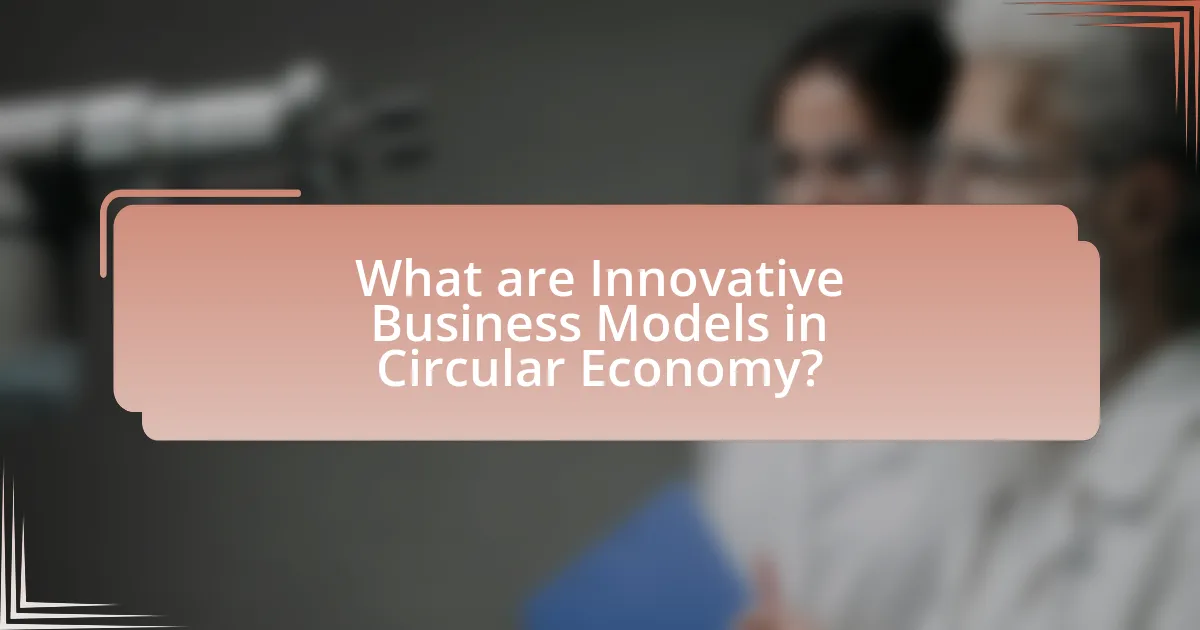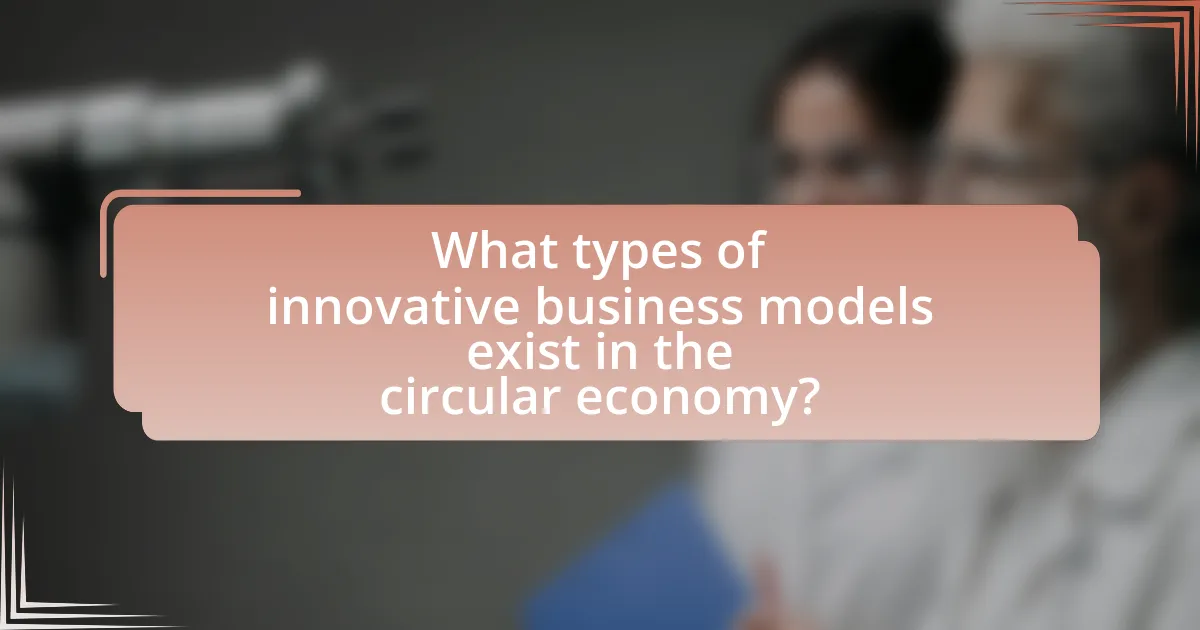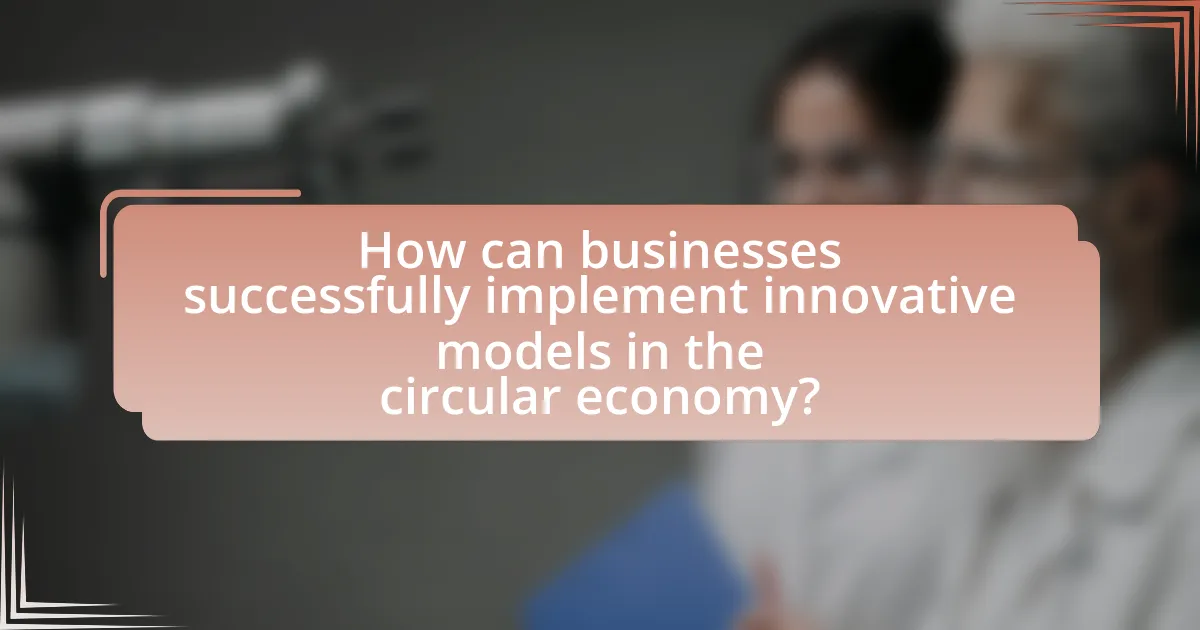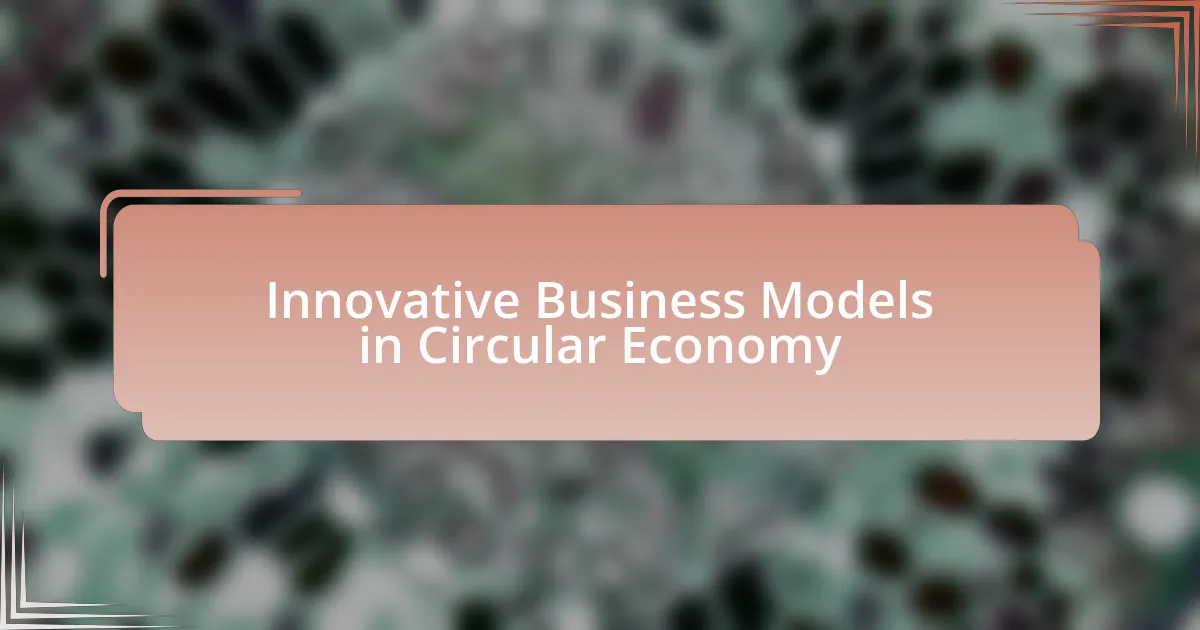Innovative business models in the circular economy prioritize resource efficiency and waste reduction through strategies such as product-as-a-service, closed-loop systems, and collaborative consumption. These models contrast with traditional linear approaches by emphasizing sustainability, longevity, and recyclability of products. Key principles include resource efficiency and waste minimization, which significantly enhance sustainability and can lead to substantial economic benefits. The article explores various innovative models, including product-as-a-service and take-back schemes, and discusses their implementation, challenges, and best practices for businesses aiming to thrive in a circular economy.

What are Innovative Business Models in Circular Economy?
Innovative business models in the circular economy focus on maximizing resource efficiency and minimizing waste through strategies such as product-as-a-service, closed-loop systems, and collaborative consumption. These models encourage companies to design products for longevity, reuse, and recycling, thereby reducing environmental impact. For example, companies like Philips have adopted a lighting-as-a-service model, where customers pay for the use of lighting rather than purchasing the fixtures outright, promoting resource efficiency and reducing waste. This approach not only enhances customer engagement but also aligns with sustainability goals, demonstrating the effectiveness of innovative business models in driving the circular economy.
How do these business models differ from traditional models?
Innovative business models in the circular economy differ from traditional models primarily in their focus on sustainability and resource efficiency. Traditional business models typically follow a linear approach, where products are created, used, and disposed of, leading to waste. In contrast, circular economy models emphasize the continual use of resources through practices such as recycling, remanufacturing, and sharing, thereby minimizing waste and environmental impact. For example, companies like Patagonia and IKEA have adopted circular practices by designing products for longevity and recyclability, which contrasts sharply with the traditional model of planned obsolescence. This shift not only reduces resource consumption but also creates new revenue streams through services like product leasing and take-back programs, demonstrating a fundamental change in how value is generated and perceived in the marketplace.
What principles define circular economy business models?
Circular economy business models are defined by principles such as resource efficiency, waste minimization, and product lifecycle extension. These principles emphasize the importance of designing products for longevity, reusability, and recyclability, thereby reducing the consumption of finite resources. For instance, according to the Ellen MacArthur Foundation, transitioning to a circular economy could generate $4.5 trillion in economic benefits by 2030 through improved resource productivity and reduced waste. This demonstrates the viability and necessity of adopting circular economy principles in business models.
How do these principles impact sustainability?
The principles of innovative business models in the circular economy significantly enhance sustainability by promoting resource efficiency and waste reduction. These models prioritize the reuse, recycling, and regeneration of materials, which minimizes environmental impact and conserves natural resources. For instance, a study by the Ellen MacArthur Foundation highlights that transitioning to a circular economy could reduce global greenhouse gas emissions by 39% by 2030, demonstrating the potential for substantial environmental benefits. By integrating these principles, businesses can create closed-loop systems that not only support sustainable practices but also drive economic growth through innovation and efficiency.
Why are innovative business models essential for the circular economy?
Innovative business models are essential for the circular economy because they facilitate resource efficiency and waste reduction. These models enable companies to rethink traditional linear approaches by promoting practices such as product-as-a-service, where products are leased rather than sold, thereby extending their lifecycle and minimizing waste. For instance, a study by the Ellen MacArthur Foundation highlights that transitioning to circular business models could generate $4.5 trillion in economic benefits by 2030, demonstrating their potential impact on sustainability and profitability.
What challenges do traditional business models face in sustainability?
Traditional business models face significant challenges in sustainability due to their linear nature, which prioritizes profit maximization over environmental and social considerations. This linear approach often leads to resource depletion, increased waste, and a lack of adaptability to changing consumer demands for sustainable practices. For instance, a study by the Ellen MacArthur Foundation highlights that traditional models contribute to a circular economy’s inefficiency, as they do not incorporate recycling or resource regeneration, resulting in a projected $4.5 trillion economic opportunity lost by 2030 if sustainability is not integrated. Additionally, regulatory pressures and shifting consumer preferences towards sustainable products further complicate the viability of these traditional models, necessitating a transition to more innovative, circular approaches that prioritize sustainability.
How do innovative models address these challenges?
Innovative models address challenges in the circular economy by promoting resource efficiency, waste reduction, and sustainable practices. These models, such as product-as-a-service and closed-loop systems, facilitate the reuse and recycling of materials, thereby minimizing environmental impact. For instance, companies like Philips have adopted a circular lighting model where they retain ownership of the materials, ensuring they are reused at the end of the product’s life cycle. This approach not only reduces waste but also creates a continuous flow of resources, demonstrating a practical solution to the challenges of sustainability and resource scarcity.

What types of innovative business models exist in the circular economy?
Innovative business models in the circular economy include product-as-a-service, take-back schemes, and closed-loop supply chains. Product-as-a-service allows companies to retain ownership of products while customers pay for usage, promoting longevity and reducing waste. Take-back schemes incentivize consumers to return products for recycling or refurbishment, thus minimizing landfill contributions. Closed-loop supply chains focus on reusing materials within the production process, effectively reducing resource extraction and environmental impact. These models are supported by the increasing demand for sustainability and resource efficiency, as evidenced by a report from the Ellen MacArthur Foundation, which highlights the economic benefits of transitioning to circular practices.
How do product-as-a-service models function?
Product-as-a-service models function by offering products to consumers as a service rather than a one-time purchase, allowing users to access and utilize products without owning them. This model typically involves a subscription or rental agreement, where customers pay for the usage of a product over time, which encourages manufacturers to design for durability and sustainability. For example, companies like Philips provide lighting as a service, where customers pay for the light produced rather than the bulbs themselves, promoting efficient resource use and reducing waste. This approach aligns with circular economy principles by extending product life cycles and minimizing environmental impact.
What are the benefits of product-as-a-service for consumers?
Product-as-a-service offers consumers several benefits, including cost savings, flexibility, and access to the latest technology. Consumers can avoid large upfront costs by paying for the use of a product rather than purchasing it outright, which can lead to significant financial savings. Additionally, this model allows consumers to easily upgrade to newer models or switch products based on their needs, enhancing flexibility. Access to the latest technology is another advantage, as consumers can utilize high-quality products without the burden of ownership, ensuring they always have the most efficient and effective tools available. These benefits align with the principles of the circular economy, promoting sustainability and reducing waste.
How do companies implement product-as-a-service models?
Companies implement product-as-a-service models by transitioning from selling products outright to offering them as a service, which often involves leasing or subscription-based arrangements. This shift allows companies to maintain ownership of the product, ensuring ongoing revenue through service fees while promoting sustainability by encouraging product longevity and recycling. For instance, companies like Philips have adopted this model in their lighting division, providing lighting as a service, which includes maintenance and upgrades, thereby reducing waste and enhancing customer engagement. This approach aligns with circular economy principles by maximizing resource efficiency and minimizing environmental impact.
What role do take-back schemes play in circular business models?
Take-back schemes are essential components of circular business models as they facilitate the recovery and recycling of products at the end of their life cycle. These schemes enable companies to reclaim materials, reducing waste and promoting resource efficiency. For instance, a study by the Ellen MacArthur Foundation highlights that take-back programs can significantly increase the recycling rates of materials, thereby closing the loop in product life cycles. By implementing take-back schemes, businesses not only enhance sustainability but also create opportunities for innovation in product design and resource management.
How do take-back schemes encourage recycling and reuse?
Take-back schemes encourage recycling and reuse by providing consumers with a convenient way to return products at the end of their life cycle. These programs incentivize participation through rewards, such as discounts on future purchases or cash incentives, which motivate consumers to return items instead of discarding them. For example, companies like Apple and Dell have implemented take-back programs that not only facilitate the recycling of electronic waste but also promote the refurbishment of returned products, thereby extending their lifecycle. Research indicates that such initiatives can significantly increase recycling rates; for instance, a study by the Ellen MacArthur Foundation found that take-back schemes can lead to a 20-30% increase in product recovery rates.
What are the challenges in implementing take-back schemes?
Implementing take-back schemes faces several challenges, including logistical complexities, consumer participation, and regulatory compliance. Logistical complexities arise from the need to establish efficient collection and processing systems for returned products, which can be costly and require significant infrastructure. Consumer participation is often limited due to a lack of awareness or perceived inconvenience, leading to lower return rates than anticipated. Regulatory compliance can also pose challenges, as businesses must navigate varying laws and standards across different regions, which can complicate the implementation process. These factors collectively hinder the effectiveness and sustainability of take-back schemes in promoting a circular economy.

How can businesses successfully implement innovative models in the circular economy?
Businesses can successfully implement innovative models in the circular economy by adopting strategies that prioritize resource efficiency, waste reduction, and sustainable practices. This involves redesigning products for longevity, utilizing renewable materials, and establishing take-back schemes to facilitate recycling and reuse. For instance, companies like Philips have integrated circular principles by offering lighting as a service, which reduces waste and encourages product lifecycle management. Additionally, research from the Ellen MacArthur Foundation indicates that transitioning to circular business models can lead to a potential economic benefit of $4.5 trillion by 2030, highlighting the financial viability of such approaches.
What strategies can companies adopt for effective implementation?
Companies can adopt several strategies for effective implementation of innovative business models in the circular economy. First, they should prioritize stakeholder engagement to ensure alignment and support across all levels of the organization. Research indicates that companies with strong stakeholder involvement are 50% more likely to achieve successful implementation outcomes. Additionally, integrating sustainability metrics into performance evaluations can drive accountability and encourage a culture of continuous improvement. A study by the Ellen MacArthur Foundation highlights that organizations that measure their circularity progress see a 30% increase in operational efficiency. Furthermore, leveraging technology for data analytics can enhance decision-making processes, allowing companies to identify opportunities for resource optimization and waste reduction. By employing these strategies, companies can effectively navigate the complexities of transitioning to circular business models.
How can businesses measure the success of their circular initiatives?
Businesses can measure the success of their circular initiatives through key performance indicators (KPIs) such as resource recovery rates, waste reduction percentages, and customer engagement metrics. For instance, tracking the percentage of materials recycled or reused in production processes provides concrete data on resource efficiency. Additionally, measuring the reduction in waste sent to landfills can indicate the effectiveness of circular practices. Customer engagement metrics, such as the number of customers participating in take-back programs or the increase in sales of circular products, further demonstrate the impact of these initiatives. Research shows that companies implementing circular economy strategies can achieve up to a 30% reduction in operational costs, highlighting the financial benefits alongside environmental gains.
What partnerships are essential for successful circular business models?
Successful circular business models require partnerships with suppliers, customers, and waste management organizations. Suppliers are essential for sourcing sustainable materials and ensuring that products are designed for longevity and recyclability. Customers play a critical role in adopting circular practices, such as participating in take-back schemes or using products in a way that maximizes their lifecycle. Waste management organizations are vital for facilitating the collection, recycling, and repurposing of materials, thus closing the loop in the circular economy. These partnerships enable businesses to innovate, reduce waste, and create value from resources that would otherwise be discarded.
What are the common pitfalls to avoid when adopting these models?
Common pitfalls to avoid when adopting innovative business models in the circular economy include insufficient stakeholder engagement, lack of clear value propositions, and inadequate understanding of regulatory frameworks. Insufficient stakeholder engagement can lead to misalignment between business goals and community needs, resulting in resistance to change. A lack of clear value propositions may cause confusion among consumers and partners, hindering market acceptance. Additionally, inadequate understanding of regulatory frameworks can result in non-compliance, leading to legal challenges and financial penalties. These pitfalls are supported by research indicating that successful circular economy initiatives require comprehensive stakeholder involvement, clear communication of benefits, and adherence to relevant regulations.
How can businesses ensure they are genuinely circular and not just greenwashing?
Businesses can ensure they are genuinely circular by implementing transparent practices, measuring their impact, and engaging in third-party certifications. Transparency involves openly sharing supply chain processes and resource usage, which allows stakeholders to verify claims. Measuring impact through metrics such as waste reduction, resource recovery rates, and lifecycle assessments provides concrete evidence of circularity. Engaging in third-party certifications, like Cradle to Cradle or ISO 14001, adds credibility to their claims and helps distinguish genuine efforts from greenwashing. According to a 2021 report by the Ellen MacArthur Foundation, companies that adopt circular practices can reduce costs by up to 30% while improving brand loyalty, demonstrating the tangible benefits of authentic circularity.
What are the key indicators of a successful transition to a circular model?
Key indicators of a successful transition to a circular model include reduced resource consumption, increased recycling rates, and enhanced product lifecycle management. These indicators demonstrate efficiency in resource use, as evidenced by studies showing that companies adopting circular practices can reduce material costs by up to 30%. Additionally, a rise in recycling rates indicates effective waste management strategies, with countries like Sweden achieving over 99% recycling of household waste. Enhanced product lifecycle management reflects a shift towards sustainable design, where products are created for longevity and recyclability, contributing to a decrease in landfill waste and promoting a circular economy.
What best practices can businesses follow to thrive in the circular economy?
Businesses can thrive in the circular economy by implementing practices such as designing for longevity, utilizing sustainable materials, and establishing take-back programs. Designing for longevity ensures products are durable and can be repaired, which reduces waste and encourages consumer loyalty. Utilizing sustainable materials minimizes environmental impact and supports resource regeneration, as seen in companies like Patagonia, which uses recycled materials in its products. Establishing take-back programs allows businesses to reclaim products at the end of their life cycle, facilitating recycling and reducing landfill waste, a strategy successfully employed by companies like Dell, which has reported recovering over 1 billion pounds of used electronics. These practices not only enhance sustainability but also create economic opportunities and foster innovation.


